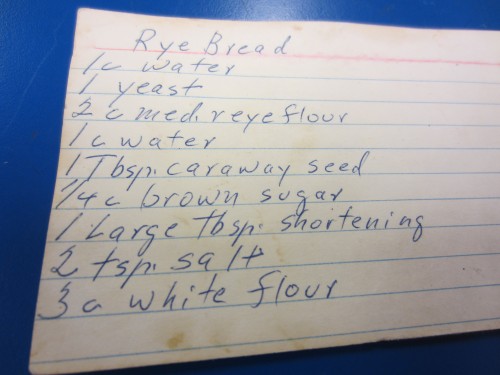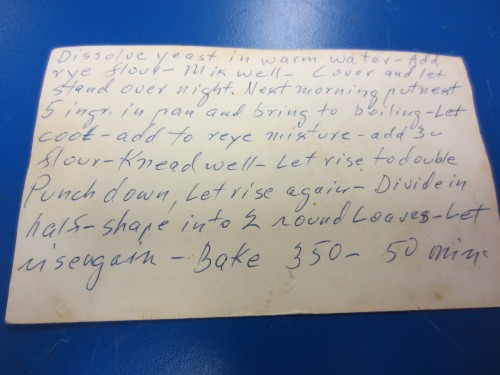When my grandmother died several years ago one of the things I wanted most when we cleaned out her house was the giant box of hand written recipes. I got it.
Many of these go back to when she was a poor child back in the early twentieth century in Munich.
I was running through them the other day and found one for rye bread.
I have never made bread in my life, but I think this could be fun. No bread machine here, we are going to do it the old fashioned way.
The directions look pretty straightforward. But I have one question that maybe the ChicagoBoyz mind hive can help me with.
The first step is to start the yeast. The card says to dissolve the yeast in warm water. The ingredient list says to use one cup of water with “1 yeast”.
I am guessing that one yeast means one packet of yeast? Any help or advice you can provide is appreciated – below the fold are photos of the recipe card. You can click on them for larger versions.


Interesting recipe. I wonder if the overnight rye + yeast mix makes it a sour dough.
It’s probably 1 packet of yeast. I doubt the precise quantity matters as long as it is fresh.
You will have fun and get a workout mixing the dough by hand. Let us know how it turns out.
I plan a follow up post, tx.
If this is an “old recipe” it would be cake yeast. It’s not as readily available as it once was. It was refrigerated and in little aluminum foil packets. My mother used to bake with it in the 50’s and early 60’s.
“I wonder if the overnight rye + yeast mix makes it a sour dough.”
A sour dough comes from a sour dough starter. Yeast alone doesn’t make sough dough.
“Sourdough is a dough containing a Lactobacillus culture in symbiotic combination with yeasts. It is one of the principal means of biological leavening in bread baking, the others using cultivated forms of yeast (Saccharomyces). It is important in baking rye-based breads, where yeast does not produce comparable results. Compared to breads made with baker’s yeast it produces a mildly sour taste because of the lactic acid produced by the lactobacilli.”
http://en.wikipedia.org/wiki/Sour_dough
@Marliese – that is what I am afraid of. I am hoping that the packet yeast will do the trick. I guess there is one way to find out.
Dan,
I *think* if it were a really old recipe and therefore German, it would be in metric weight instead of cups and tsp. Obviously it it written in English, but while I can imagine someone translating the text, the measurements would be a pain. I agree with Marliese that if it is a middle aged recipe it probably means one cake.
I also agree with Jonathan that the precise measure isn’t that important.
For what it is worth, I make bread every week and use 3 TBS. yeast to 6 cups of water and about a half a cup of molasses. It looks like she’s using 2 cups of water and a quarter cup of sugar, so call it a third of my recipe, I’d go with a tablespoon or a packet. I doubt more would hurt it any.
I disagree however on the work out part. I don’t find it amounts to much in that regard. Hauling fence posts up hill, clearing brush, stacking hay — that’s a work out. I’m not sure where that reputation comes from, maybe some people do too much.
Hope that helps a little.
Thanks John, much appreciated.
In Europe, the northern and eastern areas relied more on rye, which is heartier, although less productive, than wheat. They therefore, made rye bread with sourdough. They couldn’t produce much wine because their growing season was too short, so they made beer. They made lagers which are bottom fermented.
The English could grow wheat and made ale. Ale is top fermented and so produces lots of extra yeast that can be channeled into baking.
In Mediterranean areas, they could grow grapes and make wine, which has more alcohol than beer. But they dind’t have much yeast, so they too relied on sour dough to make bread.
John, I believe, is correct.
I tablespoon is a bit more than a packet which is 2 1/4 teaspoons.
With the overnight rise, one packet is enough yeast.
Yeast with a German sounding name. In packets. What grandma used.
Fleischmann’s Yeast in those packets is in every supermarket I use. I usually buy the jar instead of the packet and keep it in the frig. I am trying to lose weight so don’t make or eat as much bread lately,
A yeasty thesaurus:
http://www.foodsubs.com/LeavenYeast.html
(deleted by Dan)
This is using a technique similar to using a “poolish” or a pate fermente (the difference being mainly hydration pct, with a poolish being a 1:1 mixture of flour to water, usually). Basically you make a small amount of dough (or at a bakery you’d simply have some left over) that you let rise overnight and then you add that to the rest of the bread. Usually you end up adding more yeast to it though, so this is a little unusual.
I’d say try starting out with about 1/2 a teaspoon of ordinary active dry yeast. Alternately you can try adding 1/8 teaspoon of yeast to the mixture to sit overnight and then add 1 and 1/2 teaspoons of yeast when you add everything together.
I’m curious to see how it comes out.
Thanks Robin. I am going to try to make it according to the recipe first. My grandmother was always first and foremost quite German in her ways so I am sure the recipe is authentic and is likely the recipe that my grandfather preferred. The great variable is that if she “forgot” a step or ingredient or techninque on the recipe card. We shall see. I plan on trying it this weekend and will put up a follow up post.
Go to Gordon’s Food Service if there is one near you and you can buy a large amount of yeast for the same amount it will cost for a small jar in the supermarket. In my area, the local supermarkets don’t carry large bags of flour either, but Gordon’s does.
Thanks Becky, I didn’t even know about GFS but I think I am going to like them.
Just as a note, Dan – I have a little wooden recipe box from my grandmother, which must be about the same size as yours. Some of the recipes are hand-written on cards, just like yours, and others are cut from magazines. I had a mad thought a couple of years ago to copy them all over … I have a picture that I took of it, guarded by one of my daughter’s cats, which I will post sometime over the weekend.
I hope the rye bread turns out amazing – that was the stuff that the German settlers in Texas missed, when they first came over, and they were crushed to find out that rye didn’t thrive in the Hill Country all that well.
A standard packet or cake of yeast is the equivalent of 1 Tablespoon of the active dry yeast you can buy today.
sounds like she made it with what I learned to call a ‘sponge’. Mixing up the yeast, some of the liquid, some of the flour, and letting it rise before adding the rest of the ingredients. I’m mildly surprised there’s no sugar in that sponge. In my experience, yeast grows a lot better with a bit of sugar. Anyway, sponges tend to make a finer grained loaf.
Rye has little or no gluten, that’s why rye bread is so much smaller than wheat, and why rye bread is usually made with a mixture of rye and wheat flour, as here.
The proper temperature for warm water to activate yeast is 110-115F. Haven’t made rye bread in years, but when I did make it, I learned I prefered orange peel to caraway as the flavoring. The boiling water the next day may be to warm up the dough and encourage it to grow some more.
Jonathan:
I wonder if the overnight rye + yeast mix makes it a sour dough.”
Robert Schwartz
A sour dough comes from a sour dough starter. Yeast alone doesn’t make sough dough.
Letting the yeast mixture set overnight will impart a sour taste to the bread, whether it fits any purported standard of Sourdough Bread or not. Try it.
I started my rye dough today. It’s rising although I sort of mixed two recipes, one that includes bread flour in the sponge. We’ll see how it goes. I’m in Tucson which has a much better kitchen. My daughter will play the role of tester. She’s a senior at U of A.